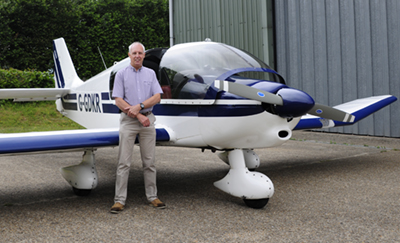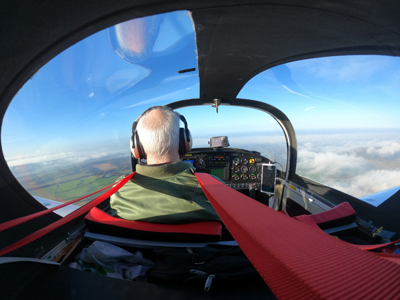Want to Learn to Fly?

two tonnes with no more than four people on board, like this
fabulous Robin DR400.
Many people would like to learn to fly, but the cost is often too high. Before you decide whether to learn, and where, the crucial decision to make is what you want to fly, as this has a major impact on the cost — not just of getting a pilot's licence but in keeping up your flying afterwards. This latter aspect is not always considered, but for most will be the biggest cost if added up over many years. It's tempting to think, "I want to be able to fly everything," or "I'll just get a licence now and decide later." As with the section on my Instructor page, please note that General Aviation licensing was updated on 1st October 2025, and these changes are now reflected here. The new regulations reduce the time and cost of getting a licence, and provide a more-progressive upgrade path through the various licences. The old system did not provide an upgrade path from a National licence (NPPL) to a full PPL, and this has now changed. If you already have a licence, then the changes will also apply to you. However, the decisions already taken might not let you take full advantage of the changes. The changes reduce the time and cost of training, and introduce a more-progressive upgrade path through the various licenses.
So, the first decision to make comes down to three questions:
- What you want to do with your licence when you get it? Where do you want to fly, do you want to carry passengers, and how many at once, do you want to fly for a week away, or just a day trip?
- How much flying would you like to do? How often would you like to fly, and how many hours a year?
- How much flying can you afford to do? The total cost of flying varies according to how many hours you fly, how much you pay (or it costs) per hour, and any fixed costs.
These three questions are usually in conflict, so a compromise is needed, and this is where you really need to consider all the options.The sidebar on my Instructor page has a table showing the approximate number of hours you can fly on different aircraft types for a fixed budget of £5,000 per year. Since some costs are fixed regardless, and some are hourly, then the final number doesn't scale simply — the best option will vary depending on the annual budget. Simple maths will allow you to do the sums for your own budget, but bear in mind that a larger syndicate will work out cheaper (on the monthly cost at least), but a smaller syndicate will have better availability of the aircraft. I've replicated the table below.
A budget of £5,000 per year will get you the following (at approximate 2025 prices, though they vary by region):
- Hiring Cessna 152: £159/hour, no monthly fee = 31 hours
- Hiring Cessna 172: £219/hour, no monthly fee = 23 hours
- Share in a PA-28 or Robin DR400: £120/hour + £100/month = 32 hours
- Share in a SkyRanger microlight: £30/hour + £45/month = 150 hours
- Own a Group A or microlight Eurostar or Eurofox: £20/hour + £3000/year = 100 hours
For those not aware of the complexities of flying, there are several types of aircraft. Not only does the licencing vary between them, but costs, especially maintenance costs, vary a lot as well.
- Part-21 aircraft. This group covers larger aircraft such as the Piper PA-28 and Cessna 152 and 172, plus larger aircraft up to 5.7 tonnes. Part-21 are what were formerly EASA aircraft, before the UK left EASA. They operate on a Certificate of Airworthiness (CofA) and virtually all of the maintenance must be done by a maintenance company employing licensed engineers. The aircraft above-right is a Robin DR400, a four-seat Part-21 aircraft.
- Non-Part-21 aircraft. These operate mostly on a Permit to Fly, usually by the Light Aircraft Association. It is permitted for the owner (or someone else) to do most of the maintenance, although certain things need to be signed off by an LAA inspector. Many of the smaller (2-seat) aircraft in this category are powered by Rotax engines, which are generally more economical on fuel than the traditional Lycoming and Continental engines, and usually can use standard petrol rather than the more-expensive AvGas. The image below-left shows me flying a Pioneer 300 (non-Part-21), which can comfortably cruise at 130 knots (150mph), burning only 20 litres an hour of standard car petrol. A typical Piper PA-28, by comparison, cruises at around 105 knots (120mph), burning 32 litres an hour of AvGas.
- Microlights. These also come into the non-Part-21 category, but can be flown on a different licence that can be quicker and easier to get. They have a maximum weight and are limited to two seats. Maintenance is the same as the type above. Many people think of microlights as limited to flex-wing aircraft (like a flying motorbike), but most are now conventional aircraft. A change to the regulations a few years ago raised the maximum weight from 450kg to 600kg, allowing much more sophisticated (and expensive) aircraft, some capable of high speed and long range.

Someone who had owned several Part-21 aircraft told me that the cost of owning one was £10,000-15,000 per year in maintenance, parking (hangarage is even more expensive and in high demand) and insurance. A non-Part-21 aircraft, such as a microlight or other small two-seater, may cost as little as £3,000-4,000 per year (depending on the type and parking or hangarage), and is normally much more economical on fuel.
There are some downsides to microlights, apart from the obvious seating limitation. They are limited (at the moment) to daytime VFR (i.e. you are not allowed to fly at night, in cloud or in poor visibility, or in Class A airspace). However, you can now use them to revalidate a PPL or LAPL, and hours in a microlight now count towards the minimum hours needed for revalidation. Currently, microlights may not be used to train for a PPL, but there is now an upgrade path from NPPL to PPL, so some of this limitation is less important. There's now no minimum number of hours required to upgrade through the licences (upgrading to a PPL currently previously gave no credit for NPPL hours), with the training left to the dicretion fo the flight school. Most people won't reach the required standard in the suggested time, so some hours will still be needed in a Part-21 aircraft. Many training schools can't or won't offer this progressive option, though, so you would need to arrange this separately.
To repeat — I suggest you consider all options carefully before deciding which way to go, and consider the costs and practicalities before committing. Speak to flight schools and pilots, but above all try both types, microlight and Part-21, before making a final decision — don't knock it until you've tried it! I say all this as someone who has both a PPL and an NPPL, so I'm fairly neutral. Instructors and flight schools will want to promote their own training, and may be out of date or just plain wrong. If they tell you that microlights are not real aeroplanes, and they can't do very much, you might want to walk away and talk to someone else, because that's outright prejudice, and usually based on ignorance. Remember, it's about what YOU want, not what the flight school wants you to have.
You might want to look at an article I wrote in Pilot magazine, which was well received. You can read it here, by kind permission of the publishers.






